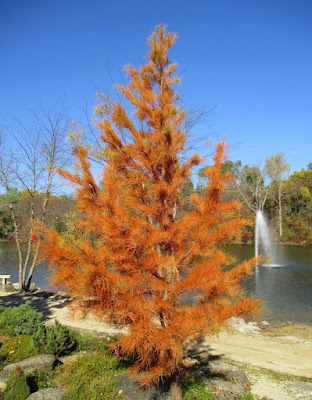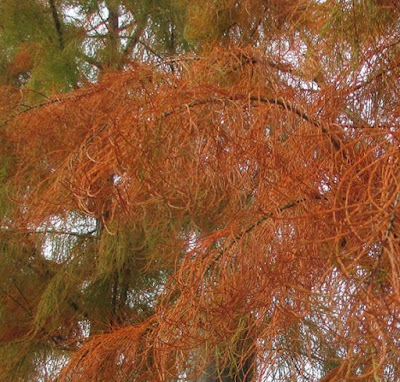|
|
 |
| Taxodium ascendens - Pond Cypress |
Taxodium ascendens commonly known as Pond Cypress is native
to North American the southeastern United States, from southern Delaware to
southeastern Louisiana and south into Florida except for the Florida Keys. It
is a long living tree, this plant is estimated at 1000 years. This figure may
be an underestimate, as The Senator, until recently growing in Longwood,
Florida's Big Tree Park, was estimated to be over 3,400 years old.
Pond Cypress slow growing average tree grows 15 – 18 m (50 –
60 ft) in height. It has a narrower crown, is smaller, and has a more open
habit. The bark is a paler gray color. Like Bald Cypresses, Pond Cypresses
growing in water have a usually growth trait called cypress knees; these are
woody limb pneumatophores sent above the water from the roots, perhaps enabling
this plant to inhale air in habitat with flooded soil. The trunk is expanded at
the base, even on young trees, assisting the tree in anchoring in the soft,
muddy soil. This tree will grow best in a moist to wet area. Ideally it prefers
slight acidity but will tolerate any moisture retentive soil. Best in full sun
though can tolerate some light shade. The area where still black-water rivers,
ponds and swamps without silt-rich flood deposits. It predominates in cypress
dome habitats.
Like as Bald Cypress, Pond Cypress also monoecious, so that
both sexes’ flowers are found in the same tree. The male and female flowers
forming on slender, tassel-like structures near the edge of branchlets. The
male and female strobili are produced from buds formed in late autumn, with
pollination in early winter. The male catkins are about 10 cm (4 in) long. The
young seed cones are green and become grayish brown when mature. They are
globular in shape and not over 2.5 cm (1 in) in diameter.
T. ascendens, also plant as ornamental plant in
tub or in the park near the pond.
 |
| Taxodium ascendens - Pond Cypress |
 |
| Young Plants of Pond Cypress |
 |
| Leaves of Pond Cypress |
 |
| Taxodium ascendens Leaves |
 |
| Pond Cypress Leaves |
 |
| Pond Cypress in Fall |
 |
| Male Flowers of Pond Cypress |
 |
| Taxodium ascendens Male Flowers |
 |
| Pond Cypress Mature Male Flowers |
 |
| Female Cones of Pond Cypress |
 |
| Taxodium ascendens Female cones |
 |
| Pond Cypress Conese |
 |
| Pond Cypress Male Flowers and Cones are in same tree |
 |
| Bark of Pond Cypress |
 |
| Taxodium ascendens Log |
 |
| Logs of Pond Cypress |
 |
| Ornamental Plants of Pond Cypress |
 |
| Pond Cypress in Park |
 |
| Taxodium ascendens Ornamental Plants |
 |
| Taxodium ascendens in fall |
 |
| Taxodium ascendens - Pond Cypress |
 |
| Taxodium ascendens - Pond Cypress |
 |
| Taxodium ascendens - Pond Cypress |
 |
| Taxodium ascendens - Pond Cypress |
 |
| Taxodium ascendens - Pond Cypress |
 |
| Taxodium ascendens - Pond Cypress |
 |
| Taxodium ascendens - Pond Cypress |
 |
| Taxodium ascendens - Pond Cypress |
Video of Pond Cypress:
No comments:
Post a Comment